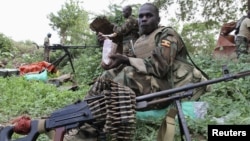NAIROBI - The U.N. humanitarian affairs office says it is still waiting for African Union and Somali forces to say which parts of the Afgoye corridor aid groups can access to help more than 400,000 internally displaced Somalis. AU and Somali government forces seized control of the corridor from militants last week.
The head of the U.N. Office for the Coordination of Humanitarian Affairs (UNOCHA) in Somalia, Justin Brady said his organization is working closely with other aid agencies that have some access along the Afgoye corridor, as security officials continue to assess the situation on the ground.
"We are working very closely with the U.N. security to assess one of the possible [ways] for the agencies' funds and programs to move their life saving operations into the corridor, initially to make [an] assessment [of] what exactly is required of those populations," he said. "And we stand ready with our contingency plan; there are resources in place, prepositioned in some cases, that will allow us to respond very quickly on urgent needs, and we look forward to the opportunity to be able to get the better idea of the exact requirements.”
On Sunday, Somali government and African Union forces cleared the last pockets of al-Shabab resistance from Elasha Biyaha, a region west of Mogadishu and home to more than 400,000 internally displaced refugees.
On Friday, Somali and AU fighters seized control of Afgoye, a major town in Elasha Biyaha. They have also reopened the road between Afgoye and Mogadishu. Somali officials say 20 al-Shabab militants were killed in the five-day operation to take the town.
Since the operation began, thousands of people have fled back to Mogadishu to escape heavy fighting in the area. Brady noted there were also people who fled to Baidoa, in Somalia’s Bay region.
"Some [IDPs] have moved out of the corridor to Mogadishu," he said. "The latest report we have is some 10,000 have moved in or returned to their former homes in a state of disrepair, or into the existing camps in Mogadishu. We have also some reports of dislocation towards Baidoa. For those who are in the corridor, we [are] still assessing [the] situation as we gain access, to understand the exact needs of [that] population."
Al-Shabab has held the Afgoye corridor for years in its campaign to overthrow Somalia's U.N.-backed transitional government and impose strict Islamic law.
The group once controlled most of southern and central Somalia, but has steadily lost ground in the past 18 months to AU, Somali, Kenyan and Ethiopian forces.
Somalia has not had a stable government since its former dictator, Mohamed Siad Barre, fled the country in 1991.
The head of the U.N. Office for the Coordination of Humanitarian Affairs (UNOCHA) in Somalia, Justin Brady said his organization is working closely with other aid agencies that have some access along the Afgoye corridor, as security officials continue to assess the situation on the ground.
"We are working very closely with the U.N. security to assess one of the possible [ways] for the agencies' funds and programs to move their life saving operations into the corridor, initially to make [an] assessment [of] what exactly is required of those populations," he said. "And we stand ready with our contingency plan; there are resources in place, prepositioned in some cases, that will allow us to respond very quickly on urgent needs, and we look forward to the opportunity to be able to get the better idea of the exact requirements.”
On Sunday, Somali government and African Union forces cleared the last pockets of al-Shabab resistance from Elasha Biyaha, a region west of Mogadishu and home to more than 400,000 internally displaced refugees.
On Friday, Somali and AU fighters seized control of Afgoye, a major town in Elasha Biyaha. They have also reopened the road between Afgoye and Mogadishu. Somali officials say 20 al-Shabab militants were killed in the five-day operation to take the town.
Since the operation began, thousands of people have fled back to Mogadishu to escape heavy fighting in the area. Brady noted there were also people who fled to Baidoa, in Somalia’s Bay region.
"Some [IDPs] have moved out of the corridor to Mogadishu," he said. "The latest report we have is some 10,000 have moved in or returned to their former homes in a state of disrepair, or into the existing camps in Mogadishu. We have also some reports of dislocation towards Baidoa. For those who are in the corridor, we [are] still assessing [the] situation as we gain access, to understand the exact needs of [that] population."
Al-Shabab has held the Afgoye corridor for years in its campaign to overthrow Somalia's U.N.-backed transitional government and impose strict Islamic law.
The group once controlled most of southern and central Somalia, but has steadily lost ground in the past 18 months to AU, Somali, Kenyan and Ethiopian forces.
Somalia has not had a stable government since its former dictator, Mohamed Siad Barre, fled the country in 1991.







